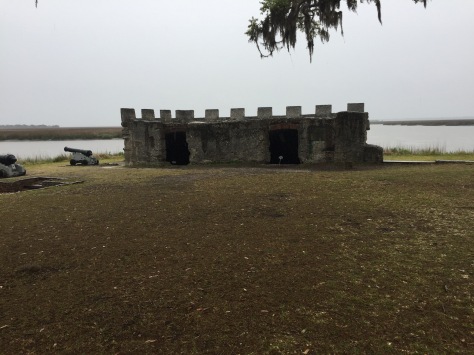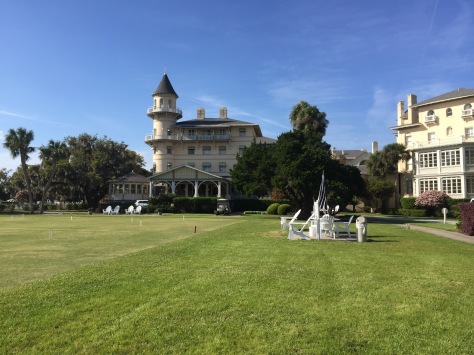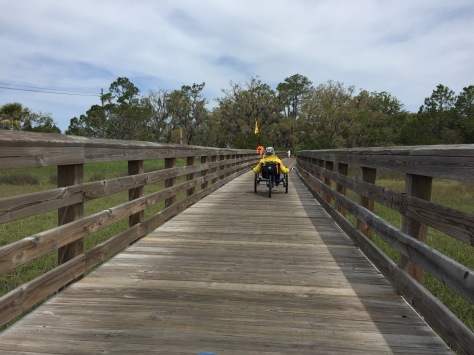When we left you last, we had explored northern Florida in an area that had been contested by the French and the Spanish back in the 1500’s. On Thursday, we moved a mere 70 miles up the road to Brunswick, Georgia. Here we found stories of the pre-Revolutionary British, the Civil War, the early 20th Century elite, and modern day foreign trade. With only a few days here it was not only a lot to discover, but it was hard to keep it all straight!
We began by pulling into our first Boondockers Welcome location. This is a program where people allow you to camp on their property for free. This particular location was hosted by Leslie and Skipper, and they were just super to us. We even hung out with them one evening around their fire pit, and got to know them and their neighbors over cocktails. To show our appreciation for their hospitality, we gave them a small gift bag with some goodies from Michigan. 🙂

They lost several trees during Hurricane Irma. Fortunately, they all fell across the driveway when no one was home. Thank you again, Leslie and Skipper!
On Friday, we headed out to St. Simons Island. This particular barrier island is home to Fort Fredrica, an 18th Century British outpost and townsite. The settlement was put into place under the watchful eye of James Oglethorpe; a soldier, member of Parliament, and a visionary. His plan was to establish somewhat of a Utopia for people in debtors prisons back in England, all the while creating a buffer between British colonies to the north and the Spanish to the south. A fort was erected along the Altamaha River in 1734, and a fortified town was laid out just behind it. There were 84 lots, most of which were 60 by 90 feet. Each family also received 50 acres in the surrounding countryside to raise crops. As the town began to spring up, the Spanish to the south took notice. Sensing the rising tensions, Oglethorpe sailed back to England and brought back a regimen of over 600 soldiers. In 1740, the British went on the offensive and set sail for St. Augustine. The ships bombarded the Spanish fort for two weeks straight to no avail. Details as to just why that was, can be viewed in our post on St. Augustine by clicking here. The British headed back to Fredrica and the Spanish followed not too long afterwards. They brought an army of 2000 men with the intention of taking the fort and town. Unfortunately for them, the British were more familiar with the area and their troops and townsfolk used guerrilla tactics to chase the Spanish soldiers back south. Without too much bloodshed, the skirmish ended and order was restored.

When we arrived we requested our Junior Ranger materials, and enjoyed the movie and displays in the visitor’s center. Not letting the fairly steady rain deter us, we headed out through the town-site to the fort. The river has changed course, so much of the location of the fort is now underwater. A couple of magazines remain above ground. The foundations of many structures have been unearthed by extensive archaeological studies, including the storehouse which John Wesley lived above. We were able to make out the earthen berms that were the base of the fort’s walls, as well as footings of many of the homes.

The town’s streets were well marked, as were each of the foundations. After we received our badges, we went to explore the rest of the island.
Across from the fort is this monument and memorial garden to John and Charles Wesley.

John Wesley is the founder of the Methodist Church. Diana is United Methodist and was pretty excited to walk the same ground as John Wesley, especially on Good Friday. He made five separate trips to Fredica from England in 1736 and 1737. It was after leaving Georgia for the last time that he began the Methodist Church. There is a large Methodist conference center and museum on the island. We drove around the beautiful campus, but were too late to tour the museum.
We also visited the St. Simons Lighthouse.

This impressive structure looked very familiar to us. It turns out that the engineer responsible for it was a man named Orlando Metcalfe Poe. He was General Sherman’s chief engineer who accompanied him on his March to the Sea near the end of the Civil War. After the war, Poe became the chief engineer of the U.S. Lighthouse Service. He developed this style of lighthouse and St. Simons was constructed in 1872. Just prior to that, Poe was promoted to become the Great Lakes lighthouse chief engineer, as the region’s burgeoning shipping industry required sentinels to keep them safe. He oversaw the construction of 8 lighthouses on the Great Lakes that used this same design. He also designed the first of the Soo Locks, which was named after him. He was injured during its construction and died of a subsequent infection in Detroit shortly afterwards. He is buried in Arlington National Cemetery. His lock, which he never saw completed, was totally rebuilt in the 1960’s to allow 1000 foot freighters to pass between Lake Superior and the lower lakes. They kept his name on it. 🙂

The view from the top is outstanding! The original 3rd order Fresnel lens is still in use.
While we were at the top of the tower, we asked a local woman about the ships pictured above. Brunswick is home to a huge port that deals with ‘roll off-roll on’ cargo, in other words…vehicles.

This is a screenshot of the port from Google Maps. The five rows in the area circled in red contains over 3000 cars and trucks. Considering all the other vehicles in the lots, there has to be well over 50,000 of them there! We saw several of those ships coming and going while we were in Brunswick, so they must really employ a lot of people to move those cars.
On Saturday, we made our way to Jekyll Island for a bike ride. We had scoped it out on Thursday evening, and we found the paths on the island to be favorable for our TerraTrikes.

That day, we visited Driftwood Beach. In the photo, I am looking across the water at St. Simons lighthouse.

We also toured the historic district that was established in the late 1800’s. The Jekyll Island Club attracted the wealthy elite; names like Rockefeller, Morgan, and Vanderbilt.

Here is the Rockefeller ‘cottage’. 🙂
So on our return trip, we set out to circle most of the island.

We rode through the historic district…

…over the marshes…

…and along the seashore. It was good to be back on the trikes!
That wraps up our time in Brunswick. Our next destination is Savannah, but not before a quick stop to see a good friend. Stay tuned for that adventure! Until then, safe travels to all.

Great post Jim! We may have to stop there on our way back to Key West next year. I love seeing the old “cottage” mansions and imagine being able to stay there as a visitor. When you’re in Savannah take one of the “jump on – jump off” trolley tours – they are definitely worth the money and check out all of the public squares.
LikeLiked by 1 person
Thanks for the advice on the trolley, Bob. Rick (On the Road with Maxine and Me) said the same thing!
When on St. Simons, we recommend eating at Barbara Jean’s. Very good!
LikeLike
The history of St. Simon Island is interesting, You wonder how long it took them to sail back to England to get those 600 soldiers and get back. A lot could happen in that time frame!
LikeLiked by 1 person
No kidding, Jim. I heard of two separate instances where Oglethorpe did things on his own, instead of sending a subordinate. Both worked out OK, but things could have gone sour very easily!
LikeLike
Love your historical tours! We really enjoyed Jekyll Island and especially Savannah. Looking forward to your next post!
LikeLiked by 1 person
Thanks, Steve and Dianne!
LikeLike
Such great history in that area. I can tell you’re going to have a great trip north! That is a beautiful lighthouse. Good to know they kept Poe’s name when they upgraded the locks, he sounds like a very talented guy! Area’s like the island make me miss our trykes. That wind was really blowing along the shore!!
LikeLiked by 1 person
It sure was, Jodee! We made sure we rode with the wind when we were on the ocean side of the loop. 😉
LikeLike
Great tour. Fancy digs.
LikeLiked by 1 person
Fun place to ride, Gaelyn!
LikeLike
I love Jekyll Island (St. Simons, too, but there’s something about Jekyll). We stayed in the campground there a couple of times before full-timing. I love the sea turtle rescue facility there. I see you went to Driftwood Beach, too–interesting place. Have you ever visited Cumberland Island National Seashore off the coast of St. Marys, GA? If you haven’t, you might be interested for your next visit through the area–I’ve been there several times throughout the last few years. It’s an all-day on-foot place to visit (although I hear they now do a van tour), but it’s beautiful with untouched beaches and forests, wild horses, and bit of history of the rich and famous from the early 1900s (Carnegies and the inventor of Coke–also, JFK, Jr. was married in the chapel there). I’m excited to follow the places you’ll go on you way up north. There are always new places I’m putting on our list. Safe travels! Dawn
LikeLiked by 1 person
Cumberland Island is definitely on our list for the future, Dawn! Thanks for riding along!
LikeLiked by 1 person
Love the lighthouse hope you guys are having a great time in Savannah.
It sure was great to see you guys and Maxine is missing you
LikeLiked by 1 person
It’s busy over here, Rick! Man, it was good to see you again. Tell Maxine we will see her down the road!
LikeLike